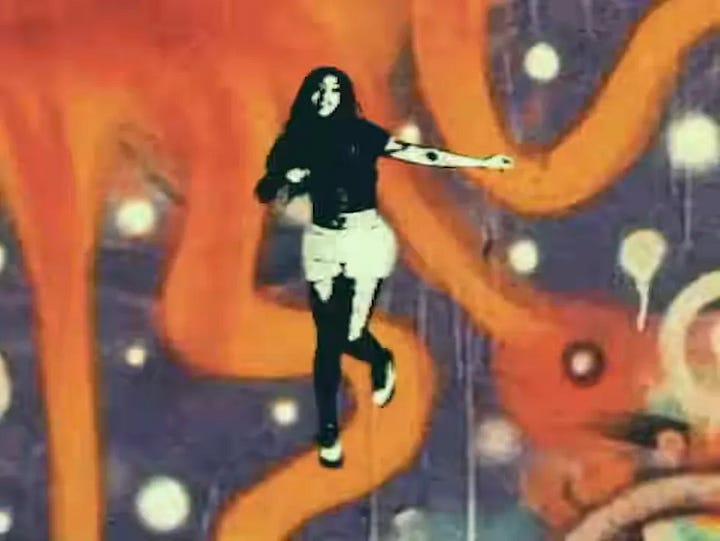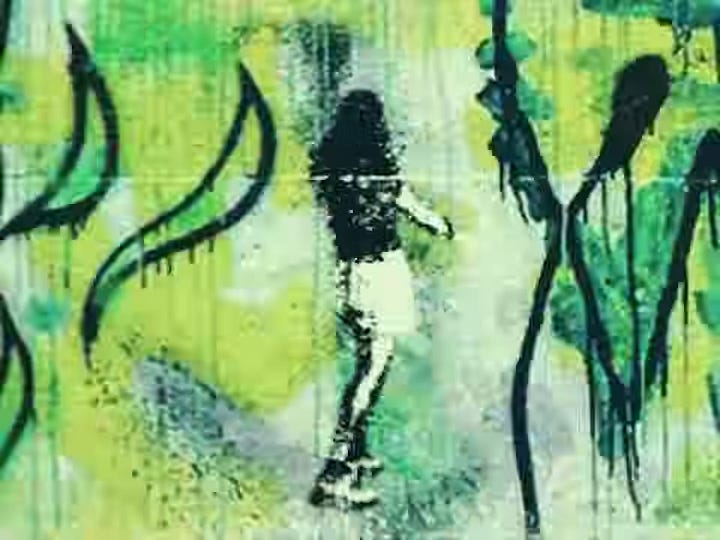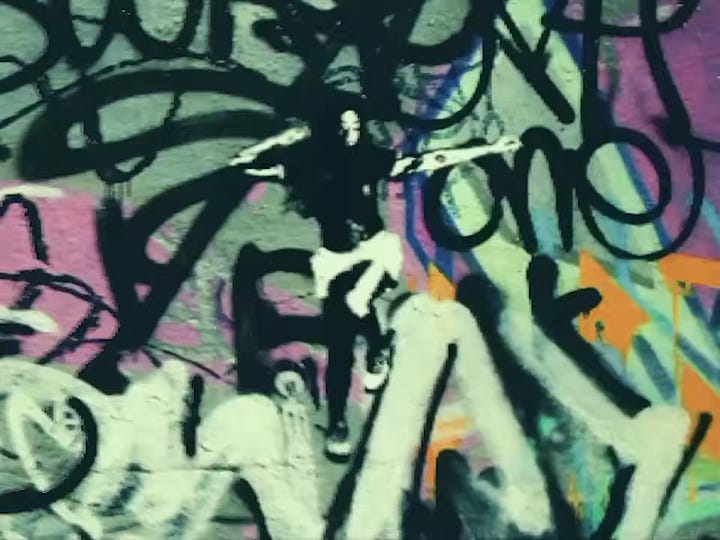Big fish—I'm otoro
2025 Mix 41: Modal musings, '20s gems, phonky funk, and the Philly drill meme my kids can't stop quoting




I’m back on my bullshit—thinking about Taylor Swift and modal music once again. (Wait, am I really going to write about Taylor Swift again this week? Yes.)
The other day I got the post-chorus from “Wood” stuck in my head, where Taylor Swift waltzes note by note down a major scale, from do to do, in a way that irritates me but clearly still serves its purpose (it is, after all, stuck in my head). At first I wondered how she could just accept this accursed melody, like a kid plinking down all the white notes on a toy keyboard. (In fact my own kids did this, spontaneously, yesterday! They have not heard “Wood.”)
But the image of Taylor Swift working out melodies on the white notes of a piano got me wondering how often Taylor Swift has sung a chromatic note—that is, a note outside the key signature of a song. (The alternative, staying within the key, is “diatonic,” but I won’t really go in to that here and will try not to throw too many music theory words around.) Chromatic notes are used sparingly in most pop melodies: they may add melodic or harmonic interest, or may help segue into or fit within a different chord, or they may be blue notes—i.e., the half-step alterations to a scale that provide the pleasing bends and near-dissonance of the blues. Most modern pop melodies don’t contain many of them, but it would also be odd for a pop artist never to use them.
I decided to skim the new album for chromatic notes. I thought I’d immediately found one: a raised sixth in the verses of “The Fate of Ophelia,” which she sings on “and if you” in the phrase “and if you never called for me” in the pre-chorus. It’s pretty, and it sounded like an unusual choice for her.
I went to the piano to work out the song and realized that what’s happening is more interesting than the single note: the song is in D minor/F major, but the verses are in what sound like G minor. With that raised sixth note, she’s actually using a mode, a different way of organizing scale intervals than just major or minor. So what she’s singing isn’t G minor, it’s G Dorian.1 That means the song’s melody uses the same scale the whole time—F major, D minor, and G Dorian all have the same notes in their scales (the difference is just which note you start on).
Don’t worry too much if you don’t follow all of the music theory or “mode” stuff. The way I think about it is, you could play this melody on the piano using only the white notes. If you played the melody of “Fate of Ophelia” in the key of C major/A minor on a piano, you’d never hit a black note. The verses would be in D Dorian, the scale you get when you play all the white notes on a piano starting on D.
I wondered if it is possible that, if transposed into the right key, you might be able to play every Taylor Swift melody on the piano without ever hitting a single black note. It took me a long time to find a chromatic note—I finally found one on the title track of Showgirl, on the word “immortal” coming back into the final chorus. It’s also a little ambiguous how Swift uses blue notes.2
When I wrote about modal melody in my Taylor Swift series, I was riffing on modal music to make a provocative comparison. I was just pointing out that Taylor Swift uses similar, simple melodic phrases in different rhythmic patterns. But “Ophelia” was an interesting wrinkle, because the restriction to the same notes sounded more intentional. It’s as if she set a challenge for herself never to sing outside of the scale, no matter what chords were happening around those notes.
Coincidentally, just a few days earlier I had posted something about a more obvious experiment in melodic constraints: the remarkable soundtrack that Koji Kondo put together for The Legend of Zelda: Ocarina of Time. To create each song’s motif, Kondo used only four notes (D, F, A, and B), a limitation of the innovative game mechanic for the ocarina that Link uses, designed to be intuitive to players with no experience playing music. (It’s a series of easy-to-remember five-button combinations.) There’s a nice analysis of the construction of each song in the game’s soundtrack in this YouTube demonstration video.
These constraints led to some interesting ideas. Those four notes—D, F, A, B—are an unconventional choice; they literally spell out a D minor chord with a raised sixth, the unique note in Dorian, and the note that I noticed Taylor Swift singing in “Ophelia.” There are lots of soft, lightly jazzy melodies in the game, because any song in C major with those notes incorporates the B, a major seventh, which you hear in the main theme. And there are other interesting uses of modes: my favorite on the soundtrack, the Lost Woods theme (Saria’s Song) starts in F Lydian (the mode used for the Simpsons theme) and emphasizes that scale’s tritone in a jaunty way.
To my knowledge, “Ophelia” is one of the few times across hundreds of songs that Taylor Swift’s usual melodic palette, which sounds samey in a major key, has taken her somewhere melodically interesting.3 I should be clear that Taylor Swift’s “palette” is common in other pop music, too. But her approach to these common melodies is distinctively, er, wooden.
ETA: My full accounting for Taylor Swift melodies is in this comment. The basic stats:
By my count there are 7 songs with unambiguous blue notes in the melody, i.e. you’d want to mark it with an accidental in the sheet music.
7 songs use non-major/minor modes. These you could “play on the white notes,” but this would do a disservice to how complex/interesting they are. Almost all of these songs are from her Folkmore period or other songs with Aaron Dessner.
There are 5 modulations—in “Love Story,” “Paper Rings,” “Getaway Car,” “Betty,” and “Father Figure”—but no chromatic movement into the modulation, just a key change and then the melody restated in a new key.
2 songs are sung in harmonic minor (“Look What You Made Me Do” and “Vigilante Shit”) but she only sings the major seventh as far as I can tell, so it’s just a harmonic minor scale. That still counts as a chromatic note—there’s no way to play harmonic minor on all white notes—but it’s not really using chromatic movement.
That leaves the remaining 3 songs, which have clear chromatic movement:
“The Way I Loved You” from Fearless is in major, but she sings a minor sixth and then a minor third against a minor 4 chord (iv) leading into the first chorus (but doesn’t repeat this going into subsequent choruses).
“Gold Rush” is in major but uses a minor seventh against a minor 5 (v) chord (it has the feel of Mixolydian but she also sings the major seventh elsewhere).
“Life of a Showgirl” has a minor sixth against a minor 4 (iv) chord in the bridge.
1. Yailin la Mas Viral, Puyalo Pantera: Bing Bong
Dominican Republic
2. Zuchu: Amanda
Tanzania
You didn’t think I was going to make you listen to any Taylor Swift songs, did you? Instead I’ll give my first two tracks over to Jonathan Bogart, who is sharing his Top 50 songs of the 2020s in a Bluesky music challenge. (“Bing Bong” is technically from 2024, but it came out in November so I’m considering it for my 2025 lists.) He has written extensive blurbs for each song, so go check them out.
On Yailin la Mas Viral:
Taxonomically this is a dembow song, although it’s almost post-dembow, a series of giddy sounds in echoey space (is that one break actually just the sound of cheeks clapping?) while Yailin delivers the genre’s usual sexual provocation in a teasing tone. She’s a 23-year-old single mother (her daughter’s coo is one of the sounds in the mix) who has been in the fast-paced Dominican dembow spotlight since she was eighteen, when I first noticed her among a crowd of young women then entering the field (La Perversa, La Ross Maria, Rosaly Rubio, Arlene MC, Tokischa), but the sproingy, addictive “Bing Bong” has been her biggest pan-American hit yet.
On Zuchu:
Zuchu is one of those figures who is too important to ignore, a Tanzanian star who has been on a meteoric rise since 2019: her YouTube was at one point the most subscribed-to of any female singer’s in sub-Saharan Africa (Tyla has since surpassed her). She most often performs in Swahili, but this song, almost entirely in English and expressing a kind of rage more frequently associated with rock than amapiano, is a clear bid for listenership beyond the African continent (there’s already a remix featuring dancehall empress Spice).
3. MFS: Espa
Japan
Here’s some more surprisingly seamless global crossover in Japan, where rapper MFS incorporates dembow in a way that seems natural, if not exactly effortless. This is MFS’s third appearance on my mixes, and this is by far the fastest one she’s pulled off. I should probably listen to more of her stuff, huh.
4. PEEKABOO: Yeke Yeke
US
Detroit DJ gets the headline credit but I’m more interested in the singer (sample?), who remains elusive to my very light social media snooping. It doesn’t seem to have any relationship to the “Yeke Yeke” I already know, by Mory Kante, in either its original or hardfloor remix.
5. Nia Archives, CLIPZ: Maia Maia
UK
Nia Archives continues to glide through her do-no-wrong dnb DJ half of here career. There must be enough songs at this point to put a compilation together. I think I’ve featured about five of them to date, and I’m not even really looking for them.
6. Pedro Sampaio, Mc Gw, Mc Jhey, Mc Rodrigo do CN f. MC Nito: Sequência Feiticeira
Brazil
7. MC BF, DJ YUZAK f. MC Caja: Montagem essencial
Brazil
Two baile funk tracks that use the insistent thunk of phonk to a less oleaginous effect. The first one is a dance party that sounds practically clean-cut (not in a rush to translate) and the second is the lead track on an album I’ve come to really like by MC BF and DJ YUZAK. They’re the duo responsible for several video-game-themed songs from the last two years, notably “Ritmadinha do Mario,” covered in the Singles Jukebox. The new album uses the phonk throb as a sort of mellowing agent, sustaining the energy for a whole album.
8. Afro Bros, S.N.E. f. Stefflon Don, Egnever: Big Man Ting
Netherlands/South Africa/UK/Indonesia
Cosmo-pop stew, a little Afrobeats, dancehall, amapiano log drum, and, depending on your food metaphor, you can have either icing on the cake or a cherry on top with a sample from “Rump Shaker” running through the whole thing. (TIL, or re-learned?: that sample originally comes from “Darkest Light” by the Lafayette Afro-Rock Band.)
9. Ice Spice: Baddie Baddie
US
10. Monaleo: Putting Ya Dine
US
11. Skrilla: Doot Doot (6 7)
US
Rap suite! Ice Spice can’t seem to shake up her flow but also can’t seem to shake some of the best beats in hip-hop, so I’m not complaining. Monaleo remains underrated, I think, especially given how funny she is—I don’t think I’ve ever heard anyone compare themselves to otoro (rhymes with “on a roll,” “honor roll”).
And finally, the dark, dank source of a meme based on the police code for Report of Death that has uprooted from its huge Philly drill hit and become a playground chant, one that even my kids have caught on to (“six seven!”). Third grade folk wisdom currently sees it as a reference to the joke “why is six afraid of seven? Because seven ate nine,” and I am not in any rush to change this interpretation.
Featuring Philly drill makes me a little queasy after reading this piece in the Baffler about the sociological backdrop for some of the music. But I also can’t deny the cracked, onomatopoeic delivery (guns that go “brrpt” and cars that go “nyeeerh”) or the production—lurching horrorcore punctuated with offset firecrackers, a sweetly hummed vocal melody floating into police sirens that are mixed to make you feel paranoid when you’re driving, or at least had that effect on me.
12. Immasoul, Jeanki: Glory
Mexico
OK, let’s transition out of the rap suite with some modal rap moves from Mexico.
13. Zara Larsson: The Ambition
Sweden
Will admit that I find Zara Larsson frustratingly blank, even though I get why other people like her. This one jumped out on an album that other pop chat folk seem to like more than I do—mostly for its reasonable integration of some baile funk hard clave, done very softly.
14. bae: Cotije?
Czech Republic
Nothing to write home about, unless you live in the Czech Republic, which nudges this from a solid [6.5] to mix inclusion.
15. DRE-A f. Fanicko: Pas Toucher
Côte d’Ivoire
A little baile funk clave as an amuse-bouche before there’s a figurative eye-roll and they get down to business, Ivorian polyrhythms tumbling in on cue. A scorcher.
16. 808 Punks, Edu K: Bater cabeça e rebolar
Brazil
Millennial baile funk throwback that made me wonder if it was an old song tossed into the mix by mistake. But no, just some alt formalists who made it onto the “classy” Brazilian playlist I pull from.
17. IFE f. 7: Waruiko Remix
Japan
Eurocheeze from Japan!
18. ICM, Thoại Nghi: Đầu Hàng Đi
Vietnam
K-cheeze from Vietnam!
19. Melanie Santiler, Cimafunk: Ese Besito
Cuba
I found a decent, regularly updated playlist for Cuban music, hooray! I think I got this lead from a Rolling Stone Latin America profile which I don’t have email space to link to this week (I have something from it on next week’s mix so will talk about it then).
20. Caroline Kingsbury: Meteorite
US
[Christgau Ashlee Simpson review]
The real Chappell Roan (“Meteorite,” “Chocolate”). **
21. Zuaraz: Matina
Spain
Spanish-Mexican alt-bolero! Slow!
22. Viridianos: Casa de Caramba
France
French-Chilean post-punk so “alt” I couldn’t find it on YouTube or Bandcamp.
23. SANAM: Goblin
Lebanon
This album is very good (as was their 2023 album) but I have no space to describe it, which is convenient because it’s hard to describe. You should click through the Bandcamp link, read about it, and listen to it.
***
That it! Until next time, don’t tempt the email cutoff with extensive footnotes.
—Dave Moore (the other one)
Title from Monaleo: Putting Ya Dine
The Dorian scale is what you get when you play only the white notes on the piano starting on D. What makes it different from the minor scale is a raised sixth—the unique note that gives the scale its particular sound. You’ll find Dorian in a lot of pop music going for an elegiac or mysterious feel (“Scarborough Fair” and “Light My Fire” use it for elegy and mystery, respectively).
I learned modes as a kid by playing “only the white notes” starting on different keys. C is Ionian/major, D is Dorian, E is Phrygian, F is Lydian, G is Mixolydian, A is Aeolian/minor, B is Locrian. I still mix up the names, but I do remember how each scale sounds.
ETA: See this comment below for a more exhaustive accounting of blue notes and other chromatic notes.
“Does Taylor Swift sing blue notes?” is another interesting question. To me the answer is “yes, but”—she will often give little vocal hints of blue notes, but only indirectly, as if she’s caught the blue note on the way from one diatonic (“in-key”) note to the next.
Stevie Nicks has a Taylor Swift-like melodic simplicity, too, but from an almost opposite approach. You have a much stronger feeling of the blues scale from how Nicks bends her notes (“SAW my reflection…” in “Landslide,” e.g.). This gives her the sense of writing blues-derived melodies that technically don’t have blue notes on paper. They come across as softer and sweeter while retaining a sort of ghostly dissonance.
She also moves into Dorian on “Invisible String,” where on the phrase “tying you to me” she’s singing the F# (the song is in D) but the chord changes to an A minor, where F# is a raised sixth, i.e. the “Dorian note.”
What’s really interesting about “Invisible String” is that there’s another note that seems like a chromatic note: a minor seventh. However, she never sings the major seventh in the song, even though the major seventh is a note she sings frequently in songs in a major key (the major seventh is the first note in “Love Story”). So you can still play the entirety of “Invisible String” on only white notes, because it’s in Mixolydian. You’d never hit a black note if you played the whole melody in G on the piano.
There are a few other oddities in the catalog. (I haven’t explored it exhaustively; you should tell me what I’m missing.) “Cassandra” moves somewhat rigidly between C minor and G minor, repeating a simple melodic phrase, but in two different keys. The vocal melody is limited enough that it doesn’t reveal an obvious mode by itself; you could play the whole melody on a piano and never hit a black note if you played the sections in D minor and A minor. This is more of an asterisked technicality, though, not really true to the spirit of the exercise — hence paragraph three of footnote three, where only the sickos will read it.


Beatles' "Norwegian Wood" is in Dorian, right? Iirc, I got that insight from a televised Leonard Bernstein young people's concert back in the day.
It's one of two Beatles songs (1) that are good songs, but not close to my Beatle favorites ("Wood" not even in the top 5 on Rubber Soul) and (2) that have totally ear-wormed me to the point that I've hummed or whistled or sung it at least once a week (if not more) since the age of fifteen, while maybe in my adult life actually *listening* to it once every five years. (The other one is "If I Fell," which I've hum, sung even more. Don't think it's a mode song (it has a black note, though I don't know if that holds if I made the effort to transpose to other keys).)
I was at a party and the boys played pink pantheress and I was like "wow! Pp!" and they asked "do you like pp?" "I love pp" so they played bloody Zara Larson instead which I hated.
Heard monaleo for first time last week and love that Sophie Hunter flow, sweet production too. Same person was talking up Bai.